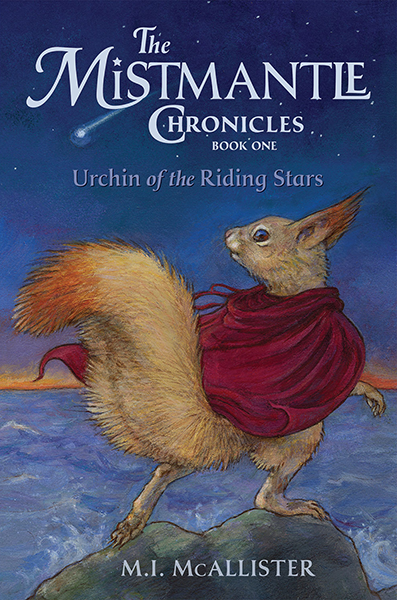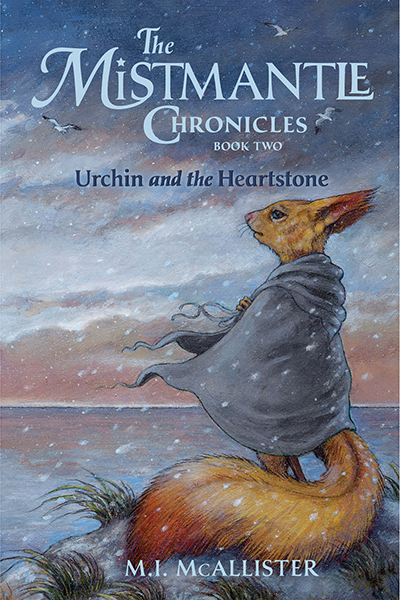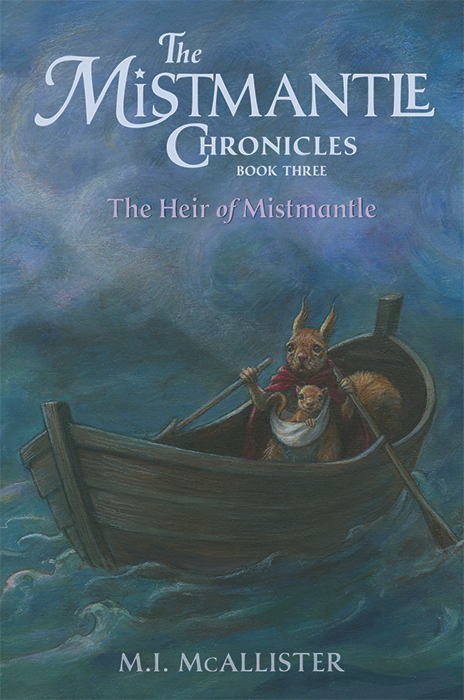In my first two reviews of the Mistmantle Chronicles (Urchin of the Riding Stars and Urchin and the Heartstone), I mentioned that I was surprised and delighted by Urchin and his adventures. I said that the openings were interesting (they are), that the writing was elegant (absolutely so), that the characters were delightful (they are), and that they were a joy to read aloud (they indeed were). Things are a bit different in this third Mistmantle Book, The Heir of Mistmantle. True to the spirit of Mistmantle, the characters in these books continue to be a wonderful blend of sweet, funny, loyal, brave, and true. But, as this was originally intended to be the final book in a trilogy, there is something more, something different in this story.


When Mistmantle was originally published, one of McAllister’s publishers requested only a trilogy, while her other publisher requested two additional books (and we are so glad to have those extra stories). McAllister used her third book to tell a poignant story that required our favorite characters to mature and come of age as would be fitting to the end of a trilogy. In this book, The Heir of Mistmantle, there is a kind of darkness that feels more intense and is more complex than that which is in the first two books. Overcoming this darkness requires bravery and selflessness from all of the animals on Mistmantle instead of the heroic acts of just a few.

To explain this book, I must assume that you are okay with knowing what is going on in Mistmantle when this story opens. From this point on, I will assume that you have read the first two Mistmantle books, or that you do not mind some small spoilers.
When this book opens, the island of Mistmantle is preparing for the birth of a new princess. Our beloved King Crispin has married again and is eagerly awaiting the birth of his heir. Sadly, the joyous naming ceremony for Princess Catkin is eclipsed by several catastrophic events which occur at more or less the same time: Brother Juniper receives a terrible vision, plague breaks out on the island, some islanders are whispering that there are Husk sightings, and Princess Catkin is kidnapped. While each of these items resolves by the end of the book, there is a great deal of suffering that happens along the way, and there is some tragic loss. Graceful, as always, the light overtakes the darkness, but not without some cost.
I love that McAllister tells these kinds of stories for our children (and, honestly, for us as well). None of these topics is easy to deal with, but all of them are worked out well. And all of them give our young people something substantial to chew on as they read. As I have said in the reviews of the first two books, I submit that these are excellent stories that stretch our young people properly and in a way that edifies them. I wholeheartedly recommend this one overall and sincerely enjoyed reading it. I will, however, as always, point out some of the content that parents may wish to know about in advance so they can decide what is best for when and how to share this with their children.
First, there are deaths in this book, but there is one in particular that stings readers of the first two books. That said, the way in which this character dies is noble, and McAllister allows us to grieve with the characters as they mourn. Also, she includes some beautiful liturgical scenes honoring the dead that help us to appreciate the gift of this character’s life.
Second, the animals of the island of Mistmantle are reeling from a physical plague they cannot seem to cure, as well as another kind of moral plague that is equally stubborn. While the animals fight about why the plague exists, who is to blame for it, and how to cure it, they forget that they belong to each other. It takes a lot of work, but ultimately King Crispin is able to inspire the right kind of healing by calling out the danger of malicious gossip and unregulated fear.
Third, we have known since the second book that Juniper is also an orphan. In this story, we learn his tragic story. Parents will want to know that, as Brother Fir hints in the second book, this story is hard for little ones to wrestle with. Juniper is born out of wedlock, and his father is an evil character who tried to erase Juniper’s existence. As adults reading this section, we know much better than an innocent child reader what this means. The sin is real, and it features prominently in part of the story arc. That said, it is told in such a way that the innocence of our little ones is preserved. It is a hard part of the story, and it causes Juniper to struggle mightily. For much of the second half of the book, Juniper considers himself unfit to live. While Juniper would never harm himself intentionally, he continually seeks out dangerous opportunities for heroism in the hope that he can trade his blemished existence to save the lives of what he considers to be more noble animals, like Urchin. If parents are concerned about this storyline, I passionately encourage you to pre-read this book.
Fourth, and this is the hardest one, the worst villain in this story is the disease of mental illness. Princess Catkin is kidnapped by a grieving widow who has lost the capacity for rational decision-making. This well-intentioned character sincerely believes she is doing the right thing for the princess, but she is so lost in the chaos of her grief and her subsequent mental illness that she makes a cascade of bad decisions that endanger the princess and wreak havoc on the island. McAllisters paints a very accurate picture of mental health struggles–both for the person afflicted as well as for their support system. The animals of Mistmantle work to find and rescue Catkin without unnecessarily endangering the kidnapper. And, when it resolves and then twists again (as mental illness is wont to do), McAllister’s animals show us anew how to respond with love and safety. It is a very hard storyline. But, as I said above, so gracefully handled. Readers are left feeling great sympathy for all involved. This storyline may frighten young ones, but it is probably less scary to them than Husk was in book one. I think that, like Juniper’s story, it is adults who will feel the brunt of this heaviness as we know better how to read between the lines.
I continue to be amazed that these books are not more well known. I would have devoured them as a young reader, and they would have nourished me well. McAllister’s love for her readers is evident on every page. She is telling stories that entertain while they edify. I have finished reading the fourth book Urchin and the Raven War and cannot wait for you to read this one and continue on to that one. Heir of Mistmantle feels like a satisfying end to a great story arc. Urchin and the Raven War is a thrilling and passionate revival that builds on the intrigue and hope of Urchin and the Heartstone.
You can read our reviews of Urchin of the Riding Stars and Urchin and the Heartstone. You can learn more about the Mistmantle books at Biblioguides, here. And you can purchase these beautiful books from Purple House Press, here.